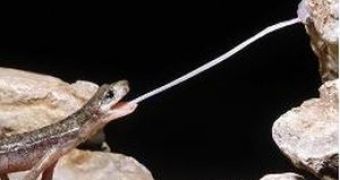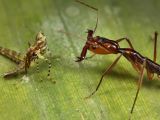There's nothing faster on the ground than a cheetah on the hunt. The maximum speed is of 112 km (70 mi) per hour, but the average hunting speed is still of 72-90 km (46-56 mi) per hour. The elastic spine and the long legs allow the cheetah to make successive jumps 7 m (23 ft) in length each and in 2 seconds a cheetah has already reached 75 km per hour and in 3 even 110 km (that's faster than most cars can do!). Its most rapid preys, the gazelles, do not overcome 80 km (50 mi) per hour.
Air opposes less resistance than the ground, and birds, of course, reach much faster speeds. The Peregrine The Peregrine Falcon is often stated to be the fastest animal on the planet in its hunting dive, the stoop, which involves soaring to a great height and then diving steeply at speeds of over 322 km/h (200 mph) hitting one wing of its prey, so as not to harm itself on impact. Measurements of real stoops by using radar found maximum diving speeds of only 140 km/h (87 mph).
But the falcon's speed is not based on muscle movement. The smallest hummingbirds fly with 80 wing beats per second, a rhythm at which the human retina cannot naturally detect details and during the courtship displays, the male flap his wings up to 200 times per second!
Still, the most rapid muscle involving movements in the vertebrate world come from cold blooded species. The chameleon is famous for its tongue, which is the longest in the world compared to the body length, in most species being as long as the body and tail combined. The tongue is launched and put back in a fraction of second (0.04 s the launch (!), 0.5 s the put back). No wonder a chameleon can catch 4 flies in 3 seconds...
Still, the chameleon's tongue is sluggish compared to the tongue of som salamanders from the Americas employing the same hunting technique. The giant palm salamander of Central America (Bolitoglossa dofleini) shoots out its tongue at 18,000 watts of power per muscular kilogram, about twice more than the power output broken out by the previous record detainer, the Colorado River toad Bufo alvarius. Bolitoglossa extends its tongue (which measures more than half of its body length) in about 7 milliseconds, 50 times faster than an eye blink. This means 14.2 m (43 ft) per second.
The fact that the tongues were propelled outward much faster than by sheer muscle contraction made the researchers suppose there must be an unknown elastic tissue connected to the salamander's tongue that stores up the energy amounts required by the explosive projection. Tongue-launching systems are made of three components: a motor to produce energy, a spring to store it and a latch to control the unloading of the spring.
But the invertebrates come with the absolute records. The soldiers of the termite Termes panamensis, snap their jaws at a speed that bypasses any other muscle-powered movement of any species: 70.4 m (220 ft) per second (253.4 km/h or 164 mph), even if over a distance of only 1.76 mm. In the microworld of termites, this is more than enough. Researchers managed to measure the speed by filming the termite's jaws at 40,000 frames per second.
A termite's jaws have some special properties that provide power and speed. When menaced by an intruder, the termite jams its mouthparts against each other employing four sets of muscles so large that they fill half of the volume inside the insect's head. The pent-up power is what permits it to snap its jaws past one another at such incredible speed in the intruder's face. The termite's jaws work like a saw, biting with incredible strength. This helps termites defend their nest in the restricted space of animals' burrows.
The mandibles of the trap-jaw ant Odontomachus hastatus shut in the fastest reflex ever recorded in the animal kingdom. The ant's jaws accelerate from zero to 143 mph (230 km/h) in 0.13 milliseconds, 2,300 times more rapidly than the blink of an eye. When sprung against the tough body of a predator, the explosive thrust of the jaws flings the ant into the air, out of the attacker's way.

 14 DAY TRIAL //
14 DAY TRIAL // 
